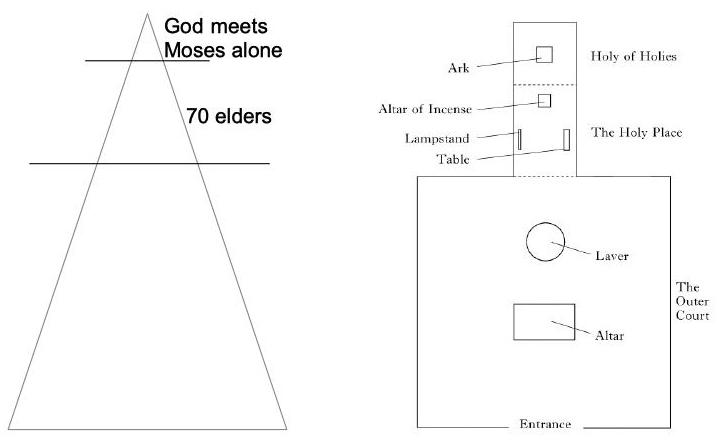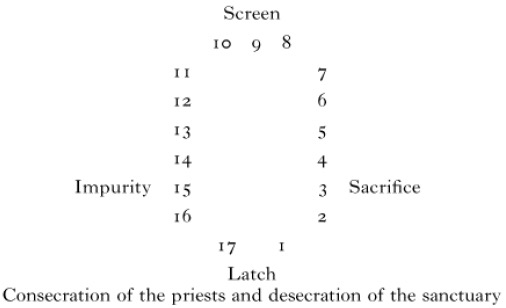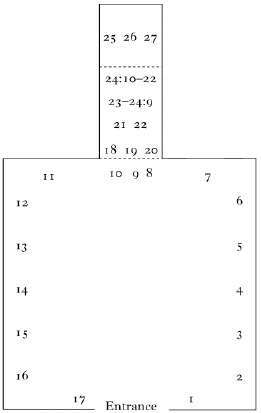 Nanine Charbonnel concludes her Prelude to her discussion of the gospels with a fascinating overview of literary technique that I think is not widely known outside the halls of academia. An author could compose a book in such a way that its thematic structure was a representation of . . . a topographical setting, or a building, or an animal — but not for any mundane reason. No, think of a place where God met and spoke with his people, or a sacred building like a tabernacle for the dwelling of God, or a sacrificial animal.
Nanine Charbonnel concludes her Prelude to her discussion of the gospels with a fascinating overview of literary technique that I think is not widely known outside the halls of academia. An author could compose a book in such a way that its thematic structure was a representation of . . . a topographical setting, or a building, or an animal — but not for any mundane reason. No, think of a place where God met and spoke with his people, or a sacred building like a tabernacle for the dwelling of God, or a sacrificial animal.

Once again NC turns to the anthropologist Mary Douglas and her book Leviticus as Literature. It is worth reading the book in its entirety in order to appreciate the anthropological foundations to her analysis. I had to pull myself away from revisiting milestone anthropological studies in order to complete this post. (There is even a book dedicated to responding to Douglas: Reading Leviticus: Responses to Mary Douglas, edited by John F. A. Sawyer. Some readers here will like to know that the last chapter in that volume is titled “Leviticus in Mark: Jesus’ Attitude to the Law”, by Alan Watson.)
Modern readers (at least most of us, I am sure) love to read from start to finish, usually as fast as comprehension will allow, with the assumption that the author has composed a linear narrative or exposition.
Now we know the Bible forbade the making of images but that did not stop authors from devising all sorts of word images. In our previous posts we have even seen how the Hebrew consonants forming words could be subject to interpretation based on their shapes and meanings (e.g. beth, meaning house). In one of our earlier posts some readers, including me, expressed some doubt that certain mystical interpretations raised by NC really did date back to the Second Temple era. We tend to think of them as kabbalistic and originating in the medieval era. NC disputed that assumption but I have not followed up her references (not wanting to take on another work of translating French at this stage). So I was intrigued to see Mary Douglas write the following:
The central idea of this book is that Leviticus exploits to the full an ancient tradition which makes a parallel between Mount Sinai and the tabernacle. Various antique transpositions between houses, bodies, and temples prepare us for believing that Ramban, the mystic philosopher and revered medieval interpreter, was drawing on very ancient traditions when he read Exodus so as to draw a parallel between the desert tabernacle and Mount Sinai. The tradition goes back to Exodus. . . .
(Douglas, 59)
Then a few pages on,
It might well be objected that this is a medieval fantasy of no relevance for Leviticus. Ramban is the name of Rabbi Nachmanides (1194–c.1270) and his conjectures might have had nothing to do with Leviticus but come straight out of thirteenth-century mysticism. Milgrom, who is well aware of this question, considers that Ramban was drawing on an ancient tradition. He bases the interpretation on the text of Exodus itself, and particularly on the name of the tabernacle as the Tent of Meeting. After considering and dismissing several speculations on the origin of the term, he says:
‘Nevertheless, the immediate archetype for P’s Tent of Meeting is not some mythic Canaanite model or hypothetical Hittite example, but the ancient Israelite tradition of the theophany at Mount Sinai. P (Exod 24: 15b; 25: 1) concurs with and indeed incorporates the epic tradition (Exod 19. 20; 20: 1) that God descended upon Sinai . . . ’ [Milgrom 1991, 142].
This was where the initial meeting between God and Moses took place. At the end of Exodus, God transferred his earthly presence to the tabernacle in the form of fire and cloud. The tabernacle thereafter became the site of all subsequent meetings. God’s direct presence is too terrible to be endured, so it is veiled in cloud, and the holy of holies in smoke of incense. The cloud is the sign of God’s presence as he journeyed with his people in their wanderings. At Sinai when all the work of the tabernacle was finished, ‘Moses was not able to enter the tent of meeting because the cloud settled upon it and the glory of the Lord filled the tabernacle’ (Exod 40: 35). In Genesis smoke of sacrifice attracted God’s attention after the flood. In Exodus the incense altar was used for the priest to send up clouds of fragrant smoke (Exod 30: 7–8, 34–8; 40: 26). Smoke impedes visibility, like a cloud.
Thus, Milgrom argues, the name ‘Tent of Meeting’ gives grounds for thinking that the correspondence between tabernacle and Sinai are at least as old as Exodus. The same argument is made by Alfred Marx when he shows that God’s presence at Sinai and his presence at the altar at the time of sacrifice are to be read as strictly parallel. The mountain and the altar are figures of one another. [Grappe and Marx 1998, 24]. It could even be older, derived from the ancient symbolism of the cosmic mountain used in Canaanite religions. The idea of a cosmic centre of the world, on a raised place, on which a shrine has been built, is common around the Mesopotamian region.
(Douglas, 62 f. My bolded highlighting)
In the diagram here I have copied Mary Douglas’s illustration of the tabernacle and placed it beside a representation of Mount Sinai.

 The lower region of Mount Sinai is where people were allowed to congregate, the middle region is where the seventy elders saw God and ate, and the peak is where God alone resided, visited only by Moses to receive the Ten Commandments. The parallels and proportions against the tabernacle are surely evident.
The lower region of Mount Sinai is where people were allowed to congregate, the middle region is where the seventy elders saw God and ate, and the peak is where God alone resided, visited only by Moses to receive the Ten Commandments. The parallels and proportions against the tabernacle are surely evident.
Now look at the plan of the Book of Leviticus. The bulk of the book (the numbers represent the chapters) applies to the lay people, their sacrifices, their cleansing and atonement, their rules for holiness, etc. In the middle, though, (8-9-10), there is a break in the theme of sacrifices and purifications of the public. This is where we meet Aaron and his sons being ordained to the priesthood. As the reader is being taken around the outer court he or she comes to the entrance to the sacred area where only priests are permitted to enter. But there is an upset here. Two of Aaron’s sons misbehave and are killed. (They attempted to bring in the wrong kind of fire.) The first chapters up to that point are then matched by other requirements (apart from sacrifices) for the holiness of the general congregation. This culminates in the ceremony of atonement for the nation (chapter 16). From there the reader moves to the inner court. A shorter section follows setting out the requirements for the priests, beginning with a unique holiness code (chapters 18-20). It is unique in that chapters 18 and 20 are a list of abominations practised by pagans round about; the central chapter, 19, is especially holy and good by contrast (e.g. love or “cherish” your neighbour). This section also ends with a savage warning narrative — the stoning of the blasphemer. (We discussed this episode in part 3c of this series.)
The textual divisions between the first and second curtains are marked with parallel references to Sinai. The curtains or division are marked textually.
Here is a rough copy of NC’s diagram based on her table on page 107:
Equivalences in Leviticus according to Mary Douglas |
|||
| Summit of the mountain (Ex 19:18)YHWH descends in smoke. Only Moses permitted access. (Ex 19:20-22) |
Holy of Holies
ark of the covenant 2nd VEIL |
Entrails
intestines, organs, genitals (washed) |
The terms of the covenant
chap. 25, 26, 27 YHWH proclaims his covenant 8 times 2nd NARRATIVE |
| Perimeter of thick cloud
Access permitted only to Moses, |
In the sanctuary: table of the showbread; the lampstand, the altar of incense.
Access reserved for the priests 1st VEIL |
The diaphragm, thick covering of fat, kidneys, the liver lobe
Burnt on the altar |
chap. 24:10-22
ch. 23-24:9 ch. 21-22 ch. 18. 19. 20 1st NARRATIVE: |
| Lower slopes, access free for all. | Area for sacrifices; General public
Free access |
Head and parts of meat
Access to the consecrated body |
Lev 1-17:
Traveling around the perimeter |
| GEOGRAPHIC SPACE: the HOLY MOUNTAIN Exodus 19, 23 |
ARCHITECTURAL SPACE: the TEMPLE or TENT (Tabernacle)Leviticus 16 |
THE BODY OF THE SACRIFICIAL ANIMAL |
THE SACRED SCROLL |
Yes, you are reading that right. Even the body of an animal is a microcosm of the cosmos and the sanctification of the people of God.
The priestly writer has several rhetorical techniques to serve his own preoccupation with due times and spaces. Though his style is quite different from the lyrical simplicity of the psalmist he also, and typically, strings one analogy after another. The analogies are complicated, because his idea is complicated. He is teaching the people of Israel to honour in their lives the order of creation, and by doing so to share in its work. The living body is his paradigm. In the space of the animal’s body he finds analogies with the tabernacle and the history of God’s revelation to Israel. When he talks about virtue, honesty, and justice, he uses simple measuring examples: ‘You shall do no wrong in judgement, in measures of length or weight or quantity. You shall have just balances, just weights’ (Lev 19: 35). The body is also treated as a measure of justice. Only the perfect body is fit to be consecrated, no animal witha blemish may be sacrificed, no priest with a blemished body shall approach the altar, ‘a man blind or lame, or one who has a mutilated face or a limb too long, or a man who has an injured foot or an injured hand, or a hunchback, or a dwarf . . . ’ (Lev 21: 16–20). Leviticus makes physical blemish correspond to blemished judgement, the scales that judge weight, length, or quantity in the market invoke the scales of divine judgement. The smallest case miniaturizes the cosmos, but it is always the same cosmos, constructed on the same principles.
(Douglas, 45 f)
Images were forbidden, but the author chose his words carefully:
In an aniconic religion, in default of pictures, the play of analogy would be likely to favour architecture and even make it a privileged medium of instruction. Leviticus is in a literary tradition that regarded the alphabet not as a conventional medium of communication but as a divine gift. Letters and word stems were respected as independent existences. Writing is not for making depictions of something that the words stand for, letters are things in themselves on which meanings can be projected. It follows that the projection of a building on a book, or a mountain on a building, does not contravene the law against images. At the same time these people made puns and enjoyed acrostics, so they appreciated the element of convention in writing. The law against images and the iconizing of letters balanced out. When the Bible forbade graven or molten images the words were carefully chosen. It did not forbid mental nor verbal images. Spatial projections over bodies and objects do not raise the spectre of idolatry. They do not seduce the eye or compete with the thought of God for the worshipper’s attention.
. . . . Leviticus is a sacred text designed on the proportions of a temple. The entrance and compartments provide a journey-type structure and the closed architecture prepares the ending. Such a turn is thoroughly in keeping with the Jewish culture, where the word has always had a privileged claim to reality.
(Douglas, 57 f)
More on that ring structure (chapters 1-17):
. . . [T]he whole construction of the book up to this point turns out to be a deliberately wrought ring with the instructions for making atonement for the tabernacle as its grand climax. The first seven chapters are about offering pure unblemished animals for free-will offerings or for atonement for sins which are listed (and which include contact with unclean things). The laws are interrupted by the narrative of the consecration of Aaron and his sons, the desecration of the sanctuary by the two sons of Aaron and their punishment by death. Then the laws are resumed, starting with chapter 11, pure and impure animals, chapters 12–15, impure humans needing atonement, and finally, chapter 16, the rite of atonement itself described.
When the circle is complete, it is clear that everything that has been said so far was designed to converge on the doctrine of atonement. The next chapter, 17, closes the ring with a latch on to the beginning.
(Douglas, 192)
There is no tabernacle when this book is being read. It belongs to a time after the destruction of the kingdoms of Israel and Judah. The text was “the image” of the tabernacle, of the meeting place between God and his chosen people. Readers are taken on a guided tour of the temple or tabernacle through the text. The Book of Leviticus is identified with the place where YHWH had (has?) his presence.
In this light the book is somewhat like a pilgrimage text. The worshippers make a journey of commemoration to a shrine and go round it with the sacred book as their guide, saying the words, marking out with their footsteps the very place of creation, or at least a space assigned by God to stand for his act of creation. Back into the problems of representation again, it is all taking place in the mind of the sixth- or fifth-century pilgrim, after the first destruction of the temple. There is no tabernacle, the faithful are not moving around in it, all the movement is in the book that they are reading, or hearing through their ears. Learning the book becomes a way of internalizing the tabernacle . . .
(Douglas, 230)
That completes the first part of Jésus-Christ, Sublime Figure de Papier. Nanine Charbonnel has prepared readers for her discussion of the gospels. Clearly we can expect to read them in the light of the literary heritage the posts in this series have been addressing.
Charbonnel, Nanine. 2017. Jésus-Christ, Sublime Figure de Papier. Paris: Berg International éditeurs.<
Douglas, Mary. 2001. Leviticus As Literature. International Edition. Oxford; New York: Oxford University Press.
If you enjoyed this post, please consider donating to Vridar. Thanks!


It is a fascinating insight that the chapters in Leviticus do indeed appear to be arranged in the form of the Temple.
I would like to point out that the writer had to choose some format for a list of laws. He did not have many options. He chose the format of the map of the building in which the laws applied. Mapping texts to buildings was the standard technique for memorizing the order of elements of a text, at least by the Hellenistic period. The priestly writer built memorizability (of the order at least) of the chapters into his text. The readers were initially (and thereafter mainly) priests, who knew the physical building. So he had a good practical reason for the order in which he wrote his text, apart from mystical reasons.
One might ask, did a Hebrew-speaking priestly writer know Greek memory techniques? Did he expect his fellow priests to know them? Was he First or Second Temple? These questions go to the date and location of the writing of Leviticus in its current form. Perhaps others can answer those questions.
I forgot to add that detail so glad you brought it up here — I mean about the use of pediments to structure events in sequence in Greek and other literature, often with the climax in the centre. Yes, these are certainly part of Mary Douglas’s discussion.
Donald Harmon Akenson makes use of architectural simile in Surpassing Wonder. The Karaites are notedly similar in their workings to the DSS sectarians of three quarters of a millenia before their emergence; and over a millenia before the DSS rediscovery. Such things aren’t neccessarily continuities. John Wansborough’s sceptical Res Ipsa Loquitur: History and Mimesis might be usefully born in mind here.
There is nothing new or esoteric or restricted to the realm of specialists about the use of architectural and other mnemonics by ancients authors and rhetoricians.
Indeed: along with Akenson, “memory palace” sprang to mind when reading this. Perhaps my impatience with NC’s over-prolonged prologue is an impediment. I rather think these chapters would be better off expanded into a stand-alone work, much as Carrier did with Proving History. This is so much more prolegomena than prologue; and it is not clear to me that these chapters accomplish what NC intends by them.
That this mnemonic technique was and is a commonplace is part of what I am getting at; we recognise it but is that recognition a false friend? What we take for a duckling might be a cygnet. Philo or Josephos might write they are doing a particular thing in interpreting their culture’s literature but was it generally understood that particular thing was in the authors’ minds when they were writing that literature?
A theme of all critical study in this area is the question “What is this literature?” i.e. what is its genre, etc. It is embattled; there is dissensus rather than consensus about almost everything to do with this literature. I don’t know, and we very probably won’t ever know. I am beginning to think we shan’t ever be able to go beyond competitive plausibilities here: that our reach much exceeds our grasp. Indeed the posssibility of grasp at all. That is speaking to it as the study of a literature. History? There are only words, and their writing has erased their antecendnts.
It is a furious industry. We massacre trees and stop up the ‘net; and for what? A technology as obsolete as horoscopy and as relevant to anything at all as Ptolomaic epicycles. 🙂
I trust readers will recognize that they are reading my own notes on NC’s book and that they are not reading her book for themselves. I do not cover every detail I read and I do not repeat the same balance of topics, space or word wise, as I thought should be evident from the way I introduce various points. I also sometimes veer off with a subpost of my own reading of a secondary work to which NC refers. All of that, along with my struggles with a language I never mastered with superior grades at school or uni.
Your criticism assumes a knowledge of the entire book and the specific relevance of details in these early chapters to her main argument but it is also clear that you have not read her book. There is nothing wrong with being a superficial reader when the purpose suits, but to go to town with smart-alec criticism on that basis does bring out an impatient streak in me.
Can you be more specific as to my perceived sin? What exactly are you seeing as “smart-alec criticism” and where am I “going to town on it?” I can’t help being a superficial reader in this instance: I don’t have access to the whole text in a good English translation. None of us do. I appreciate everything you say in your first paragraph and I appreciate the added value content and context you are providing to the book. It is ragged in places, but this isn’t the TLS.
Somewhere along the way, about when I thought I’d like to see the three introductory chapters you are epitomising and commenting expanded to stand on their own, I also thought I’d quite like to see your epitome and commentary on them expanded and published in the same way. I might not have seen where NC was going with this or quite how it ties in with “Paper Jesus”; but the content is interesting in its own right and you add substantially to that interest. I’m not trying to butter you up, nor am I laying it on with a trowel: that is what I thought.
I might consciously alter how I write for a few sentences now and again; but that would not be me and would not be genuine for longer than that. I’m a bit hard put not to say I find your response to me more than a little James McGrath and insulting, to be honest. But its the internet and I’m Aspie, so I’ll chalk it up to the lack of non-verbal cues and my conversational skills or lack of. 🙂
It appears that I misread you so I do apologize.
Accepted. Pax.
Neil, is there any benefit to understanding Charbonnel by reading Robert Alter’s previous work alongside Charbonnel; or before/after.
Also “Hebrew Bible (Alter)”. Wikipedia. “Alter’s [2018] translation aims to convey the literary style of the original Hebrew text in English, recreating as much as possible its poetic rhythms and metaphors.”
I pulled out Robert Alter’s book while reading Charbonnel’s to attempt to extend my understanding of the point being addressed. But I tend to do that with many works as they are cited in something I am reading. Charbonnel’s epilogue quote to chapter 1 of her part 1 Prelude to her book is from Robert Alter’s Art of Biblical Narrative. But the two authors are not writing about the same thing. Charbonnel is selecting data that she considers relevant to the main thesis of her book as indicated in its title.